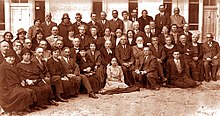
Akiva Arieh Weiss, also spelled Aryeh (1868–1947), was a Zionist activist, architect, and city planner in Palestine. He is best known as the primary founder of Tel Aviv. He had been the initiator of the project to create the "first Hebrew city" in Palestine and presided over its establishment. He also helped establish the Jewish diamond industry and textile industry in Palestine.
Biography
Weiss, a jeweler and watchmaker, was born to a Jewish family in Grodna (in present day Belarus) in 1868, but raised in Łódz, Poland. [1] Along with his wife and six children, he immigrated from Russian Poland to Palestine in 1906. [2]

As president of the then newly established building cooperative named Ahuzat Bayit, Hebrew for Building Society, Weiss wrote and presented a prospectus to the group in which he laid out his vision for a new Jewish city. [3] Arthur Ruppin's memoirs recount that Weiss demanded the creation of "a Hebrew urban centre in a healthy environment, planned according to the rules of aesthetics and modern hygiene." [4] Weiss would later on tell Ruppin; “Outside Jaffa, on the road to Petach Tikva...we intend to found a modern Jewish urban district. We already have our eye on a particular tract of land.” [4]
Currently scholarship also suggests that he likely presided over the 1909 real estate lottery (and is the leading figure in Abraham Soskin's famous photograph of the event) in which 66 Jewish families drew numbers written on seashells to determine the allocation of lots in the about-to-be established city of Tel Aviv. [5] [6] [7]
Weiss was a founder of the textile industry in Mandatory Palestine, and built the earliest textile factory, the Lodzia House. [8]
One of Weiss' visions which became reality was the establishment of a Jewish diamond industry in Palestine. [9]
Legacy
In 1956, Weiss’s children put together a posthumous collection of his works, essays and letters. The book featured an introduction by Moshe Sharett, the 2nd Prime Minister of Israel and a man of considerable stature at the time. Sharett's introduction read thus (translated from Hebrew):
"It is not always those who start things that are remembered. Sometimes they are forgotten, and those who continue and finish the work are those who ultimately win praise. This is what happened with Tel Aviv. The "first founder" was forgotten. There are no pictures of him in the mayor's office and no streets named after him….The people who have put together this book have done a good thing by making this book. Let this collection serve as a memorial to this modest and noble man who was full of ideas and actions, and whose ideas have and will came to life." [10]
House
The cornerstone of Weiss's Tel Aviv house at #2 Herzl Street was laid in 1909. Originally a single-story structure, the upper floor was added in the 1920s. The house was restored between 1996 and 2011. [11]
References
- ^ Yekutieli Kohen, Edna (2009). עיר מראשיתה. Orah ḥadashah. p. 2. OCLC 432295641.
- ^ Kohen, Edna Yekutieli. "Tel-Aviv Centennial - Akiva Aryeh Weiss (1868-1947)". boeliem.com/index.html. Boeleim; Complete Reference to Israeli Stamps. Retrieved 27 October 2014.
- ^ Azaryahu, Maoz (2007). Tel Aviv : mythography of a city. Syracuse Univ. Press. p. 50. ISBN 978-0815631293. OCLC 836349557.
- ^ a b Schlör, Joachim (1999). Tel Aviv: from dream to city. London: Reaktion Books Ltd. p. 41. ISBN 1861890338. OCLC 40798775.
- ^ Azaryahu, Maoz; Troen, Selwyn Ilan (2012). Tel-Aviv, the First Century: Visions, Designs, Actualities. Indiana University Press. p. 31. ISBN 9780253223579. Retrieved 19 April 2014.
- ^ Kosharek, Noah (20 April 2009). "Seashell lottery". Haaretz. Archived from the original on 21 November 2022. Retrieved 23 November 2012.
- ^ Rotbard, Sharon (2015). White city, black city architecture and war in Tel Aviv and Jaffa. Pluto Press. p. 49. ISBN 9780745335117. OCLC 948973465.
- ^ BarOr. "43 Nahmani Street, Tel Aviv-Jaffa – Lodzia House". amnon-baror.co.il/?lang=en. Retrieved 27 October 2014.
- ^ The Early 1900s Archived 2006-11-07 at the Wayback Machine by Shira Ami
-
^ עקיבא אריה בן יוסף חיים ויס 1868-1947 (1956–1957). ראשיתה של תל אביב תולדות ייסוד העיר ורשימות יומן [The beginning of Tel Aviv: The history of the founding of the city and diary entries] (in Hebrew). ʻAyanot, Tel-Aviv.
OCLC
1001810559.
{{ cite book}}: CS1 maint: numeric names: authors list ( link) - ^ Amnon Bar & Co. Architects. "2 Herzl St., Tel Aviv-Yafo – Akiva Arieh Weiss House". amnon-baror.co.il/?lang=en. Retrieved 27 October 2014.
- 1868 births
- 1947 deaths
- Jewellers
- Ashkenazi Jews in Mandatory Palestine
- Ashkenazi Jews from Ottoman Palestine
- 19th-century Jews from the Russian Empire
- Emigrants from the Russian Empire to the Ottoman Empire
- Mandatory Palestine people of Belarusian-Jewish descent
- Watchmakers (people)
- Businesspeople from Łódź
- Architects from Ottoman Palestine
- Urban planners
- Diamond industry in Israel
- Jewish architects
- Belarusian Zionists
- History of Tel Aviv
- Businesspeople in textiles
- Burials at Trumpeldor Cemetery
- Immigrants to Ottoman Palestine